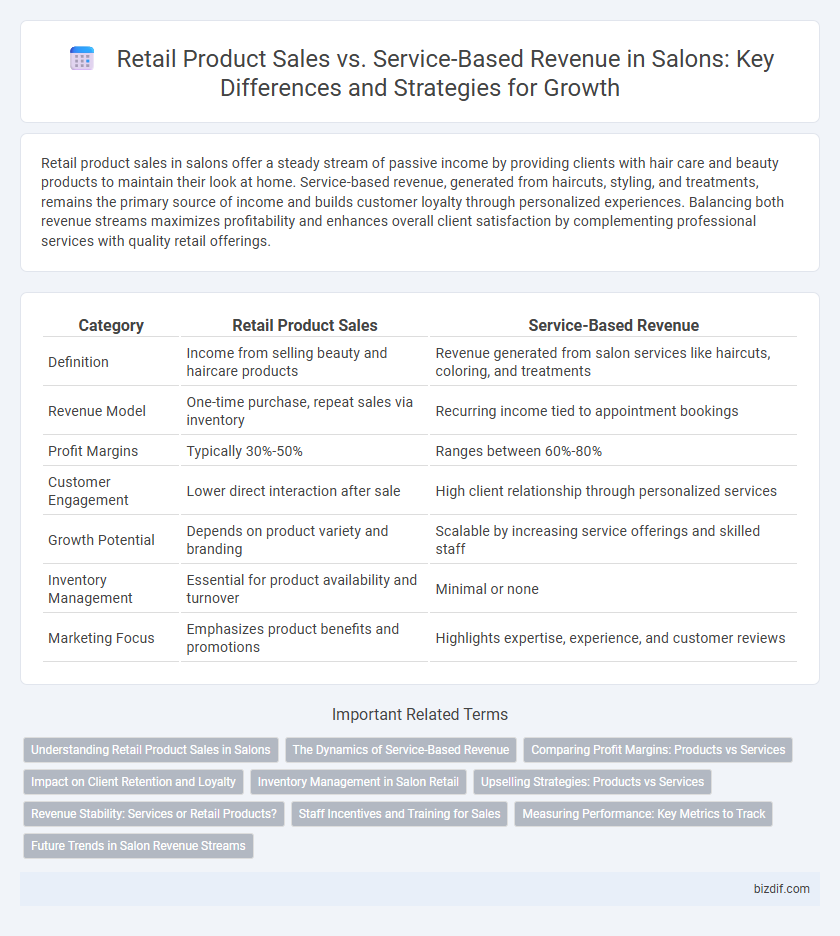Retail product sales in salons offer a steady stream of passive income by providing clients with hair care and beauty products to maintain their look at home. Service-based revenue, generated from haircuts, styling, and treatments, remains the primary source of income and builds customer loyalty through personalized experiences. Balancing both revenue streams maximizes profitability and enhances overall client satisfaction by complementing professional services with quality retail offerings.
Table of Comparison
| Category | Retail Product Sales | Service-Based Revenue |
|---|---|---|
| Definition | Income from selling beauty and haircare products | Revenue generated from salon services like haircuts, coloring, and treatments |
| Revenue Model | One-time purchase, repeat sales via inventory | Recurring income tied to appointment bookings |
| Profit Margins | Typically 30%-50% | Ranges between 60%-80% |
| Customer Engagement | Lower direct interaction after sale | High client relationship through personalized services |
| Growth Potential | Depends on product variety and branding | Scalable by increasing service offerings and skilled staff |
| Inventory Management | Essential for product availability and turnover | Minimal or none |
| Marketing Focus | Emphasizes product benefits and promotions | Highlights expertise, experience, and customer reviews |
Understanding Retail Product Sales in Salons
Salon retail product sales generate significant additional revenue by offering clients exclusive hair care, skincare, and styling products to maintain their results at home. These sales enhance client loyalty and elevate the overall salon experience while boosting profit margins beyond service-based income like haircuts and treatments. Effective upselling and knowledgeable staff recommendations are crucial for maximizing retail product revenue in competitive salon markets.
The Dynamics of Service-Based Revenue
Service-based revenue in salons primarily derives from hairstyling, coloring, and spa treatments that require skilled professionals and personalized client interaction. This revenue stream tends to generate higher profit margins compared to retail product sales due to the value-added experience and repeat client visits. Efficient scheduling, staff expertise, and customer satisfaction directly influence the stability and growth of service-based income in the salon industry.
Comparing Profit Margins: Products vs Services
Retail product sales in salons typically offer higher profit margins compared to service-based revenue due to lower variable costs and the ability to mark up products significantly. Services, while generating consistent income, often incur higher labor costs and time investments, reducing overall profit margins. Balancing product sales with premium service offerings maximizes revenue streams and enhances overall profitability in salon operations.
Impact on Client Retention and Loyalty
Retail product sales in salons enhance client retention by offering personalized home-care solutions that extend the salon experience beyond appointments. Service-based revenue establishes immediate client satisfaction through expert treatments, fostering trust and repeat visits. Combining both strategies optimizes customer loyalty by addressing diverse client needs and preferences, sustaining long-term business growth.
Inventory Management in Salon Retail
Effective inventory management in salon retail is crucial for balancing product sales with service-based revenue, as it ensures timely availability of high-demand items while minimizing overstock. Tracking inventory turnover rates and integrating point-of-sale data helps salons optimize stock levels, reduce waste, and drive profitability by aligning product offerings with client preferences. Implementing automated inventory systems enhances accuracy and supports strategic purchasing decisions that complement salon services.
Upselling Strategies: Products vs Services
Upselling strategies in salons significantly impact revenue streams by balancing retail product sales with service-based income. Emphasizing personalized product recommendations during service appointments can boost retail sales by up to 30%, while enhancing service packages and add-ons increases average ticket size by 20%. Implementing targeted upselling training for staff leads to higher client satisfaction and maximizes both product and service profitability.
Revenue Stability: Services or Retail Products?
Services in salons generate more stable revenue due to recurring appointments and client loyalty, ensuring consistent cash flow. Retail product sales can fluctuate with inventory trends and customer interest, making income less predictable. Emphasizing service-based revenue strengthens financial stability by fostering long-term client relationships and dependable scheduling.
Staff Incentives and Training for Sales
Boosting retail product sales in salons requires targeted staff incentives and specialized training that emphasize product knowledge and customer engagement techniques. Implementing commission-based rewards tied to both product sales and client satisfaction encourages stylists to actively recommend retail items alongside services. Regular workshops and role-playing scenarios enhance employees' confidence in upselling, directly increasing the overall service-based revenue and retail profit margins.
Measuring Performance: Key Metrics to Track
Tracking retail product sales alongside service-based revenue requires monitoring key performance metrics such as average transaction value (ATV), product attach rate, and service ticket size. Analyzing retail sales percentage relative to total revenue offers insights into product profitability and customer purchasing behavior. Measuring client retention rates and upsell conversion rates further optimizes strategies to balance product sales with service income.
Future Trends in Salon Revenue Streams
Retail product sales in salons are projected to grow significantly due to the rising demand for personalized skincare and haircare products, leveraging AI-driven recommendations and eco-friendly formulations. Service-based revenue will continue evolving with innovations like virtual consultations, subscription-based packages, and wellness integration to enhance customer loyalty and lifetime value. Hybrid revenue streams combining customized retail offerings with experiential services will define the future profitability and competitive advantage of modern salons.
Retail product sales vs Service-based revenue Infographic

 bizdif.com
bizdif.com